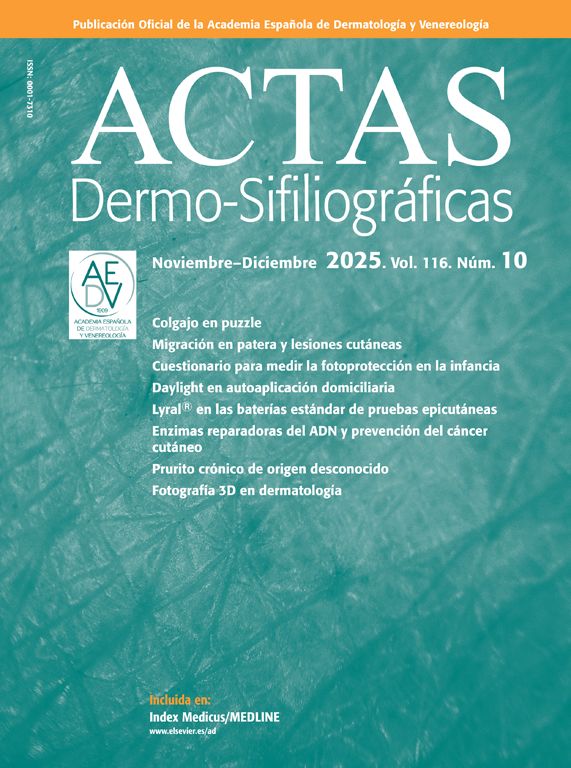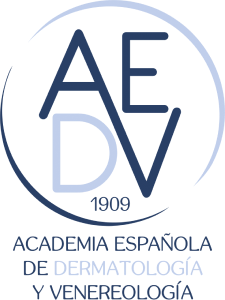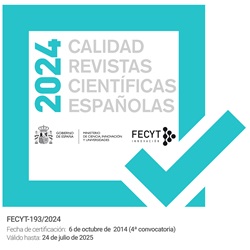The advancement flap known as the puzzle flap was first introduced by Goldberg et al. in 2005 as an alternative for small defects on the nasal ala. Although initially designed for this area, its application has been extended to other facial locations, such as the melolabial fold, auricular tragus and temple, with satisfactory aesthetic results.
Material and methodsThe present retrospective study analyzed a total of 35 cases of puzzle flaps performed by dermatologists across Spain using the multicenter case collection platform known as CLINI-AEDV.
ResultsMost patients were women, with a mean age of 70 years. Basal cell carcinoma was the most common histological diagnosis.
The most common tumor location was the nasal tip with 14 cases being reported out of 35, followed by other areas such as the nasal wing, the nasolabial fold and the retroauricular fold. Most cases, around 90%, did not exhibit immediate or late complications, with the trapdoor effect standing out as the most common complication among the rare ones. There were no recurrences of the excised lesions at the follow-up.
DiscussionThis study highlights the usefulness of puzzle flap in the reconstruction of facial defects, especially in the nasal tip and adjacent areas, as well as its successful application in other less common facial locations. Its low complication rate and absence of recurrences suggest that this technique can be considered a valid option in the surgical arsenal of every dermatologist for the reconstruction of facial skin defects.
El colgajo de avance, conocido como colgajo en puzzle, fue introducido por primera vez por Goldberg et al. en 2005 como una alternativa para pequeños defectos en el ala nasal. Aunque inicialmente fue diseñado para esta área, su aplicación se ha extendido a otras localizaciones faciales, como el surco melolabial, el trago auricular y la sien, con resultados estéticos satisfactorios.
Material y métodosEl presente estudio retrospectivo analizó 35 casos de colgajos en puzzle realizados por dermatólogos en distintos puntos del territorio español, mediante la plataforma de recogida multicéntrica de casos conocida como CLINI-AEDV.
ResultadosLa mayoría de los pacientes eran mujeres, con una edad promedio de alrededor de 70 años. El carcinoma basocelular fue el diagnóstico histológico más común.
La localización tumoral más frecuente fue la punta nasal, con 14 casos de los 35, seguida por otras áreas como el ala nasal, el surco nasogeniano y el retroauricular. La mayoría de los casos, en torno al 90%, no presentaron complicaciones inmediatas ni tardías, destacándose el efecto trampilla o trapping como la complicación más común dentro de lo infrecuente. No hubo recidivas de las lesiones extirpadas durante el seguimiento.
DiscusiónEste estudio subraya la utilidad de la plastia en puzzle en la reconstrucción de defectos faciales, especialmente en la punta nasal y las áreas adyacentes, así como su aplicación exitosa en otras localizaciones faciales menos comunes. Su baja tasa de complicaciones y la ausencia de recidivas demuestran que esta técnica puede ser considerada como una opción válida en el arsenal quirúrgico de los dermatólogos para la reconstrucción de defectos cutáneos faciales.
The advancement flap known as the puzzle (jigsaw) flap was first designed and published by Goldberg et al. in 2005 for small defects of the nasal ala adjacent to the nasogenian fold, as an alternative to full-thickness skin grafts, classic subcutaneous island pedicle flaps, transposition flaps, and second-intention healing.1 The flap – resembling a “head-and-shoulders” advancement from the cheek – mimicked a jigsaw-puzzle piece. Although it crosses 2 cosmetic units, with potential effacement of sulci, the aesthetic outcome shown in the original report was more than acceptable due to similar skin texture between the regions and concealment of scars within the melolabial and melonasal sulci; however, trapdoor deformity was reported as a complication in 2 of the 5 patients.
Since then, use of this flap has extended not only to nasal subunits other than the ala but also to sites beyond the nasal pyramid. Evidence includes the 10 cases compiled by Padilla et al., who used this repair – sometimes adding advancement and rotation – in 2 patients with defects of the melolabial fold without apparent complications,2 and 5 cases documented by Dong et al. applying the flap to the auricular tragus, antitragus, and helix with good cosmetic and functional results.3
To characterize applications of this flap in Spain, we conducted a study analyzing a series of puzzle flaps performed by dermatologists nationwide.
Materials and methodsWe conducted a retrospective, multicenter observational study of surgical defects reconstructed with a puzzle flap. Cases were collected from March through April 2024 and included procedures performed from May 2005 through January 2024 by dermatologists from the Spanish Academy of Dermatology and Venereology (AEDV), following a call via the CLINI-AEDV platform, a multicenter case-collection tool developed by the AEDV Research Unit. CLINI-AEDV was approved by Hospital Universitario Puerta de Hierro Research Ethics Committee on Medicinal Products (Majadahonda, Madrid, Spain) (10/17/2022; minutes No. 18/2022). Informed consent was obtained for cases with iconography.
Variables recorded were patient age, sex, tumor histology, greatest defect diameter, anatomic location, immediate complications (≤1 month after surgery), late complications (>1 month), and weeks from surgery to last medical assessment.
ResultsFindings are shown in Table 1. A total of 17 practicing dermatologists in Spain contributed all of their cases.
Results.
| Age (years) | Mean 77 (SD: 11.2) |
| Sex | Male 13 (37%), female 22 (63%) |
| Diagnosis | Basal cell carcinoma, 33 (94%); SCC, 1 (3%); acantholytic actinic keratosis, 1 (3%) |
| Anatomic location | Nasal tip, 14 (40%); nasal ala, 7 (20%); nasolabial fold, 3 (8%); nasal sidewall, 2 (6%); retroauricular, 2 (6%); temple, 1 (3%); malar, 1 (3%); other, 5 (14%) |
| Greatest defect diameter (mm) | Mean, 14 (SD, 4.2) |
| Immediate complications (≤1 month) | Yes, 5 (14%): trapdoor deformity, 3 (8%); dehiscence, 1 (3%); partial necrosis, 1 (3%); No, 30 (86%) |
| Late complications (>1 month) | Yes, 2 (6%): bulging, 1 (3%); paresthesias, 1 (3%); No, 33 (94%) |
In total, 35 patients were included (13 men, 22 women). Mean age was 77 years (SD, 11.2; range, 49–96).
Histology showed basal cell carcinoma in 33 cases (94%); there was 1 squamous cell carcinoma and 1 acantholytic actinic keratosis.
Regarding tumor location (Fig. 1), the nose predominated: 14 tip (40%), 7 ala (20%), and 2 sidewall (6%). In addition, 3 cases involved the nasogenian (nasolabial) fold (8%) (Fig. 2) and 2 the retroauricular area (6%); 1 case occurred in the malar region and 1 in the temple (3% each). Five cases (14%) were found at extrafacial sites.
Greatest defect diameter ranged 6–22mm (mean, 14mm). Immediate complications were absent in 30/35 cases (88%); when present, the most common one was trapdoor deformity (3 cases; 8% overall), with 1 dehiscence and 1 partial necrosis (3% each). Late complications were absent in 33 cases (94%); 1 case each of bulging and paresthesias was recorded (3% each). No patient developed tumor recurrence; median follow-up was 8 weeks.
DiscussionThis series compiles 35 puzzle flap cases.
Mean patient age was in the 70s, and nearly two-thirds were women – likely a chance finding, as the most represented tumor, basal cell carcinoma, is generally more common in men.4
Although originally designed for alar defects, our study shows the flap was most often used elsewhere. In 2/5 of cases the lesion was on the nasal tip, and success at this site likely reflects skin mobilization from the dorsum, which helps avoid undesirable tip elevation. While 23/35 cases were nasal, one-third were non-nasal, including sites not previously reported – such as the central malar region (Fig. 3) and the temple – with good cosmetic results.
No complication occurred in roughly 9 of 10 cases. The principal complication in the original report – trapdoor deformity – was seen in only 3 of 35 patients. Given the study retrospective design, we could not verify whether a deep anchoring suture at the flap margins – thought to reduce this outcome – was used. Potential cosmetic impact from sulcal effacement was not recorded.
In conclusion, this retrospective study describes the largest puzzle flap case series to date, underscoring its usefulness on the nasal tip and adjacent areas and illustrating its application and validity at other facial sites, supporting its consideration within the dermatologist's current surgical armamentarium.
FundingNone declared.
Conflicts of interestNone declared.
Ane Jaka, Elena Castro González, Marc Corbacho Monné, Teresa Solano Novo, Paula Díaz Morales, Emili Masferrer i Nuibò, José María Llamas Molina, and Cayetana Maldonado Seral.












